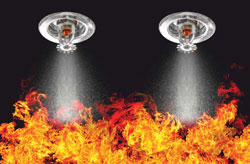Sprinklers Key To Business Resilience In The Event Of Fire
By Tom Roche, Secretary of the Business Sprinkler Alliance
We are only three months into a new decade and already fires across the nation have left lasting impacts on the businesses and local communities affected by the blazes. The first weekend of February saw fire tear through a historic building in the UK’s capital and in a commercial bakery in Wakefield, Yorkshire; only reaffirming the notion that fire is indiscriminate and will in some way damage any building of any size and nature if preventative measures remain unadopted.
To ensure history doesn’t keep repeating itself, which methods can better protect buildings, to control and extinguish fire if and when it happens?
The Effects
If uncontrolled, fire knows no limits. The fire which broke out at the commercial bakery, Speedibake, in Wakefield caused devastating effects. The blaze – which 20 fire engines, 140 firefighters and officers from West Yorkshire Police attended – damaged up to 75% of the factory’s 80m x 80m ground-floor. During the fire, and as it was being extinguished, huge palls of black smoke could be seen by local residents and shoppers going about their daily business at the neighbouring Westgate Retail Park. Although staff members continue to be paid, and customers remain a priority, the site’s future sadly hangs in jeopardy.
Thankfully nobody was seriously hurt; people were evacuated from nearby buildings, and residents within the vicinity were informed to stay indoors until the smoke had passed. This was a similar response to a fire which broke out at the Junior Lawyers’ Division dinner at the historic Law Society of England and Wales building on Chancery Lane. People from the event and those living in neighbouring buildings had to be evacuated soon after the 150 firefighters and 25 engines were called to the site at 10:40pm. Firefighters from the London Fire Brigade noted the complexity of this blaze – which took over nine hours to extinguish – particularly as it is a six-storey, Grade II listed building. Although the fire didn’t spread to any ‘key’ areas, it still destroyed the roof and a staircase from the third to the fifth floor of building 114 and damaged half of its third and fourth floor.
Chief Executive of the Law Society of England and Wales, Paul Tennant, expressed the society’s first concern was for its guests and staff. Once the society was assured of their safety, thoughts turned to the recovery of its landmark building. The fire caused significant damage to the roof and upper floors of 114, which is used as office space. Its neighbouring building however, which houses the library and Reading Room, went unscathed. For the Law Society’s London office, all 400 staff had to work remotely the following Monday.
Although both fires were extinguished by the diligent firefighting teams, the long-term effects on the bakery business are not as optimistic. As the Speedibake site suffered considerable damage, the company had to undergo a business recovery scheme to ascertain the measures which are required to be taken to get the business back up and running. As a result of the financial cost and time needed to undertake the project, Speedibake has regrettably put forward proposals to close the premises. During this consultation period, Speedibake will be prioritising its staff and will support those affected to help them find alternative employment.
It was only a year ago – March 2019 – when UK Snacks collapsed into administration a mere nine months after a huge fire. Whilst there might have been other reasons for the company’s fate, the fire would have been a contributory factor in its unfortunate demise. These incidents highlight that although insurance can support replacing equipment, the move to an alternate location to maintain business operations and support continuity efforts takes an inordinate amount of time and effort. Unless trading can continue quickly, businesses feel the financial pressure of maintaining cash flow and often flounder.
What Can Control Fire?
To prevent similar scenarios from occurring, there needs to be more proactivity. Which measures can be taken to control or extinguish fire? In these situations, a sprinkler system could have helped to avert and contain the fire.
A sprinkler system works by only activating the sprinklers in the immediate vicinity of a fire. A recent study of UK fire statistics showed that 95% of fires are controlled or even extinguished by the operation of fewer than five sprinklers, debunking the myth that if one sprinkler goes off then all of them will.[1]
Fire can be contained and extinguished by systems such as sprinklers to ensure life is not put at risk. Sprinklers also ensure businesses, jobs and the economy are also protected. Surely this is the message key stakeholders must listen to in order to enable business resilience in the event of fire? To prevent history from repeating itself and ensure little to no disruption to the communities which hold the affected premises dear?
For more information about the BSA visit the www.business-sprinkler-alliance.org
























































